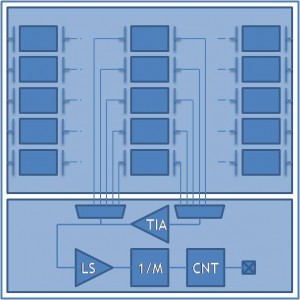MEMS Resonator Oscillator Design and Variation Study
Electromechanical resonators such as quartz crystals, surface acoustic wave (SAW) resonators, and ceramic resonators have become essential components in electronic systems. However, due to their large footprint and difficulty in integrating with CMOS process, there has been much interest in developing MEMS resonators that achieve comparable performance yet have a smaller footprint and are compatible with CMOS. Recently, MEMS resonators have been proposed that overcome physical limitations in traditional resonators to reach frequencies in the GHz range. In addition, they have the potential for compatibility with CMOS, opening up possibilities for new circuits and systems [1].

Figure 1: High-level schematic of the proposed test structure to characterize the resonant frequency of MEMS resonator array.
As with other semiconductor devices, with increasing frequency into the SHF and EHF range and with decreasing device size into the submicron scale, variability has started to become a critical issue in electromechanical resonators. Also, integration with CMOS process makes it more difficult or impossible to use the conventional frequency trimming methods employed for traditional resonators. Thus, in order for wider use of these resonators, more accurate characterization of important parameters and variations associated with these parameters is necessary. Some of these parameters include resonant frequency, the quality factor, and series resistance.
This work aims to characterize and model the variation in resonant frequency of Si-based MEMS bulk acoustic resonators. The test structure consists of an array of resonators, multiplexing structures, and an oscillator loop. During measurement, each resonator is connected into a self-sustained oscillation loop through the multiplexing structure and the oscillation frequency is measured through a digital counter. On-chip measurement circuits such as this make it possible to measure a large number of devices, otherwise difficult to do with the traditional test methods of individual device probing, thus allowing more accurate characterization and modeling of critical device parameters and variations associated with them.
References
- D. Weinstein and S.A. Bhave, “The resonant body transistor,” Nano Letters, vol.10, no. 4, pp. 1234-37 (2010). [↩]